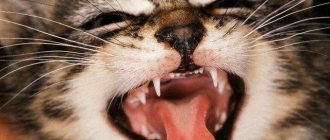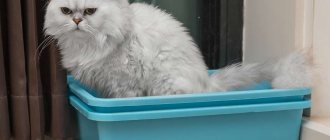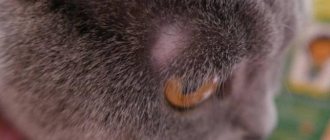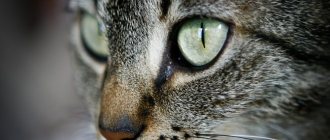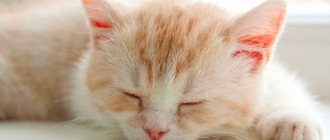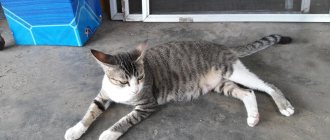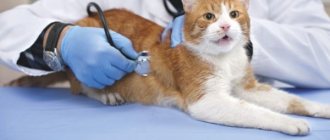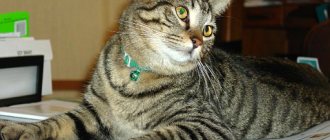What is a stroke and mini-stroke?
Stroke is a condition in which an animal’s brain suffers due to disruption of blood circulation in it. If the brain does not receive the required amount of oxygen and nutrients for a long time, its cells begin to die. As a result of blockage or damage to blood vessels, the brain may completely lose its functionality.
A microstroke is a condition in which the brain suffers from a lack of blood, which is not as severe as a stroke. It lasts no more than a day and goes away on its own, without the intervention of a veterinarian.
The causes of the disease are still unknown. It is generally accepted that stroke occurs more often in older animals (12–13 years of age). However, practice shows that the disease also occurs in animals of middle age – 7–9 years.
Drugs prescribed for stroke
IMPORTANT! Do not self-treat your cat without consulting a veterinarian.
- Cordiamin. Prescribed for administration in the first three days. The drug affects the central nervous system, stimulates the vasomotor and respiratory centers. For cats, the recommended dosage is 0.1-0.12 ml per kilogram of weight. The injection is subcutaneous, but it can also be injected into the muscle. Sulfocamphocaine has a similar effect, but unlike the first drug, it also has an effect on the myocardium. They inject into the muscle twice a day.
- Eufillin. Improves the function of the respiratory muscles, helps enrich the blood with oxygen and reduce carbon dioxide levels. Subcutaneous administration at a dosage of 0.1-0.2 ml per kilogram of weight.
- No-shpa - tablets or injections. Once a day. Relieves spasms.
- Gamavit is a multivitamin complex.
- Thiotriazolin. Helps normalize lipid, protein and carbohydrate metabolism. Affects the liver and gallbladder, restores hepatocytes and activates the antioxidant system. If the cat weighs less than three kilograms, then a dosage of 1/4 of the tablet or 0.5 ml intramuscularly is adequate. If the weight is over 3 kg, then half a tablet or 1 ml/kg is prescribed. Reception - twice a day.
- Neuromidin (1.5%). The action is aimed at improving memory, accelerating the conduction of impulses along nerve fibers and increasing the contractility of smooth muscle organs. For cats weighing up to 5 kg, the dosage is 0.2 ml. Injects once into the muscle.
- Piracetam. Improves blood supply to the brain. Single injection, 0.5-1 ml.
- Furosemide. Anti-edema. 0.5-1 ml/kg intramuscularly or subcutaneously is sufficient.
- Glucose (5%). Helps supply the body with the energy necessary for the functioning of organs, enhances metabolic processes and dilates blood vessels, promotes the outflow of fluid and enhances the liver’s ability to cleanse the blood of toxins. 15-20 ml once a day is enough.
- Cerucal. Anti-vomiting. Dosage per 10 kg of animal weight - 0.3-0.7 ml. Administration is allowed up to three times during the day.
All treatment and dosage must be prescribed by the doctor individually, based on the results of the tests performed. Therapy should be carried out immediately and also aimed at eliminating the cause. If after three days of treatment no dynamics are observed, the prognosis is disappointing.
The cat may be in the hospital for three to five days. This will allow you to adjust the treatment if necessary.
Clinical picture, diagnosis
What symptoms of a microstroke in a cat can you pay attention to right away? It’s easy to suspect that something is very “wrong” with your pet. He simply begins to behave inappropriately. The first signs of impaired cerebral circulation may be strange behavior. The cat freezes for a long time, staring into emptiness, and suddenly “dies away” without showing any signs of concern. Such symptoms mean that some areas of the cerebral cortex are temporarily “switched off”, and the animal itself does not notice this, its consciousness does not have time to register temporary gaps. True, sometimes the cat looks slightly puzzled, but only the most attentive owners notice this.
Symptoms and treatment of microstroke
A microstroke is a brief circulatory disorder affecting a small area of the brain. With a micro-stroke, the symptoms are practically no different from a stroke, but the animal recovers much faster. Within a day, the cat comes to its senses, is interested in food, and the signs of paralysis are smoothed out.
Typically, the clinical picture of a microstroke develops in cats as follows:
- Sharp headache. The cat may stand against the wall and rest its forehead against it or try to hide in a dark place. Does not respond to calling or stroking. Slowly, barely moving his paws, he wanders around the apartment.
- The cat becomes lethargic and sleepy. May fall over as it loses orientation in space.
- The pet does not recognize the owners - it is afraid of them, or, on the contrary, shows sudden aggression. This is due to memory loss.
- Brief seizures may occur. Often - on the affected side of the body.
- The cat constantly vomits, even when the cat's stomach is already empty.
Cat has a headache
Treatment of a microstroke is aimed at relieving the symptoms of the consequences and restoring cerebral circulation. The doctor prescribes antiemetics, nutritional solutions, and painkillers.
Important! For severe convulsions, anesthesia is indicated.
How a stroke manifests itself - what to pay attention to
After a cerebrovascular accident, the pet exhibits unusual behavior that cannot go unnoticed by an attentive owner. Stroke in cats has the following main symptoms:
- Bowed head at a “strange” angle – most often on one side. It is explained by the rapidly developing weakness of the neck muscles, which can persist for a long time after the onset of the pathology (up to several weeks).
- Impaired movement coordination. An agile and agile pet suddenly becomes clumsy, acquires a shaky gait, does not maintain balance, constantly falls on its side, and moves unnaturally in a circle.
- Ataxia is the inability of a cat to perform its usual routine movements due to muscle weakness throughout the body (for example, it cannot raise its paw to wash its face).
- Changes in behavior, disorientation, inexplicable fear. After a stroke, the cat becomes literally illogical and unusual. Confusion is noted, the pet may avoid its owners or even rush at them, hiding somewhere from fear. Veterinarians explain this fact by probable memory loss, when the animal does not remember the people around him, the environment, or his basic cat skills.
- Temporary blindness may develop - after a stroke, a cat will obviously bump into objects, fall from objects (furniture, thresholds), and not immediately find bowls of food. Thanks to the development of other senses, the loss of vision is usually somewhat compensated for, so it is not immediately noticed by the owner.
- Sudden lethargy. An energetic pet under normal conditions suddenly suddenly becomes lethargic and lacking initiative. She doesn't even pay attention to attempts to flirt with her.
- Decreased or complete loss of appetite. This is because the facial and throat muscles weaken, making it difficult to chew and swallow. There are risks of choking and suffocation. Loss of consciousness is also likely when bending your head towards a bowl of food.
- Asymmetric change in pupil size (anisokyria).
- Involuntary urination and/or bowel movements. Occurs when the abdominal muscles are involved in the pathological process. The animal not only does not control these processes, but also does not understand what is happening.
- Sharp tics of the eyeballs to the side back and forth (nystagmus).
- Sudden loss of consciousness, lasting from a few seconds to 5 minutes.
- After a stroke, a cat may experience limb spasms and/or paralysis. Usually one half of the body is affected.
- Signs of respiratory distress, vomiting, epileptic convulsions.
Not all owners of mustachioed pets know the signs of stroke in cats. But recovery depends on how quickly first aid is provided by a specialist.
How to help a cat
In order to help your pet, you need to properly organize first aid, take the cat to the veterinarian in a timely manner and follow rehabilitation recommendations.
First aid
The first thing to do after identifying symptoms is to seek medical help. A stroke is a dangerous condition; a visit to the veterinarian should not be put off. It is impossible to cure the pathology on your own. In order to alleviate your pet’s condition before the doctor arrives, as well as to prevent the development of some complications, you can do the following:
- take the cat in your arms and lay it on its side;
- inspect the oral cavity - a sunken tongue, foam or vomit may block the airways;
- try to calm the pet - gently hold it in your arms, stroke it, talk to it.
Unfortunately, there is nothing more you can do. The main thing you need to pay attention to is timely delivery of the cat to the veterinarian, do this as quickly as possible.
Further treatment
Before carrying out treatment, it is necessary to conduct an additional examination. Computed tomography (CT) is usually prescribed - this will allow for differential diagnosis between the ischemic and hemorrhagic forms.
In order to influence the pathological focus, one of the two drugs listed below is administered, depending on the form of the stroke. However, this is only indicated in cases where no more than a few hours have passed since the onset of the disease.
- For ischemic infarction - thrombolytics. This will dissolve the blood clot and restore blood circulation. This group of medications includes Streptokinase.
- For hemorrhagic form - hemostatic drugs. Their purpose is to prevent the progression of hemorrhage. This group of drugs includes “Aminocaproic acid”.
If more than 6 hours have passed, the use of these drugs is not advisable. In these cases, the symptoms and severity of their manifestations determine the goal and tactics of treatment for stroke in cats.
Drugs may be prescribed to support cardiac function, such as Cordiamin. Eufillin is used to support respiratory function. To eliminate cerebral edema, osmotic diuretics and glucocorticosteroids are prescribed.
First aid
As soon as you notice at least 3-4 signs of a stroke, call the veterinarian or take your pet to the clinic yourself.
Before the doctor arrives or during independent transportation, you need to lay the cat on its side on a flat surface. Make sure there is no vomit in the mouth and the tongue does not stick into the throat. Calm your pet, talk to him - your voice will not let him worry. That's ALL you need to do! Do not put a cool compress on your head - this is dangerous for hematoma, do not give medicine.
The sooner you contact a veterinarian, the easier the cat will survive the stroke and recover faster.
Risk factors
A stroke always happens suddenly, but this acute condition can be prevented if you carefully monitor your cat and undergo routine medical examinations from time to time.
Obesity in a cat
There may be several prerequisites for the occurrence of a cerebral stroke:
- autoimmune diseases;
- chronic hypertension;
- obesity;
- diabetes;
- acute and chronic intoxication of the body;
- chronic stress.
Main types of stroke
To date, two types of stroke have been identified in cats.
Hemorrhagic stroke
Occurs when a blood vessel ruptures, causing bleeding in the brain. The reasons are:
- A brain tumor.
- Physical damage to the head.
- Congenital pathology of blood vessels.
- Poisoning with toxic substances.
- Infectious diseases.
- Poisoning from drugs.
- Stress.
- High blood pressure.
- Foods excessively rich in fat.
Ischemic stroke
Occurs due to blockage of blood vessels. Main reasons:
- Heart disease in cats.
- Diseases of the urine and excretory system.
- Diseases of the endocrine system.
- Migration of parasites into the brain.
Types of disease and prognosis
In mammals, the central nervous system can function only with normal blood circulation. When blood vessels rupture or become blocked, brain tissue suffers. The prognosis of the disease depends on the type of stroke:
- Ischemic. Caused by a blood clot (thrombus) blocking a vessel in the brain. Blood clots form in the head or another part of the body. Having broken away from the site of formation, the clot travels through the bloodstream into the brain and blocks the lumen of the vessel. As a result, some part of the central nervous system starves.
- Hemorrhagic. The cause of the disease is a rupture of a blood vessel followed by bleeding in the brain. The consequences of this condition depend on the size of the damaged vessel. The larger it is, the wider the affected area and the more serious the complications.
The prognosis for animals who have suffered a stroke is often unfavorable in cases where the disease was accompanied by sepsis. Animals that have suffered a traumatic brain injury followed by a brain hemorrhage have little chance of survival.
In other cases, the cat has a chance of returning to life, although its quality may deteriorate greatly. With ischemic stroke, recovery is faster. Hemorrhagic stroke usually has more serious consequences.
For any type of stroke, the prognosis depends on how quickly and correctly first aid was provided. If the owner reacts immediately, takes the pet to the veterinarian, stays with the cat during the rehabilitation period, perhaps he will recover and live a completely full life for several more years.
Forms of the disease
Just like in humans, strokes in cats can take two forms. Depending on the type of disease, the causes of its occurrence also change. Because of this, it is very important to immediately determine the type of disease .
- Ischemic stroke - this disease occurs due to blockage of a vessel, which may appear due to a detached blood clot or a parasite that has blocked the lumen of the vessel and stopped blood circulation in it.
- Hemorrhagic stroke - this stroke is characterized by rupture of a vessel and more or less hemorrhage into the internal organs. Depending on the amount of hemorrhage, the disease can be curable or lead to the death of the animal within a few hours.
Sometimes veterinarians diagnose idiopathic stroke. This means that it was not possible to establish the nature and nature of the pathological condition. This usually happens if the veterinary clinic does not have sufficient equipment to fully examine the animal.
The symptoms of different forms of stroke in cats are the same.
© shutterstock
Possible complications
The brain is a vital organ of mammals. It regulates all body processes. The slightest damage can disrupt basic body functions.
The most severe consequence of stroke in cats is absolute or partial paralysis. There is a possibility that motor activity will never be fully restored even after rehabilitation. After a stroke, loss of vision or hearing, problems with memory and thinking are often noted.
A dangerous complication in acute strokes is aspiration pneumonia. This is an inflammation of the lungs that occurs due to the cat maintaining a recumbent position for a long time. The condition is fraught with the risk that the animal may suffocate.
Question answer
Do cats even have strokes?
Yes, sometimes. But due to the fact that owners of mustachioed pets do not know its first symptoms and do not seek help from a veterinarian, the animal often dies. And the owners are at a loss as to why the animal died or why it began to behave strangely.
What if a cat doesn't move after a stroke?
If breathing continues, the animal most likely has lost consciousness. It is necessary to immediately take the animal to the clinic to revive it and provide first aid. If there are no signs of respiratory activity, the animal is likely dead. Lack of motor activity while maintaining consciousness may indicate paralysis - unilateral or bilateral.
A cat has a stroke after anesthesia - is this possible?
Yes, it is possible - as a side effect of anesthesia drugs. Most often, the pathology develops according to the ischemic type, i.e. against the background of increased blood viscosity, a blood clot forms, which clogs the vessel and disrupts blood flow. It can occur not only in the postoperative period at the time of recovery from anesthesia, but also at the time of the operation.
Are there special drugs for stroke?
No, there are no specific special medications that could be used to cure a stroke. There is a selection of therapeutic agents that restore the cat's condition to normal, as far as possible in each specific case.
A cat has a stroke - first aid
If signs of ischemia are noticed in Murka, it is necessary to provide her with complete rest, lay her on her side on any horizontal surface and check her mouth for the presence of thick saliva or vomit, so that there are no obstructions to breathing. After this, you need to call the veterinarian home and voice the assumption that the cat most likely has a stroke, or take the pet to the veterinary clinic yourself. During transportation, you need to stroke your pet and soothe it with your voice. It is forbidden to give any medications yourself or do any injections!
How to treat a stroke in a cat?
Self-treatment of pathology is strictly prohibited! In veterinary care, it is advisable to begin therapy only after the cause has been determined. The necessary medications are usually prescribed:
- cardiac;
- restoring blood circulation;
- painkillers and anti-inflammatory;
- vascular strengthening;
- blood thinners;
- antispasmodic;
- nootropics;
- restoratives and vitamins;
- diuretics.
Causes of the disease
There are several causes of ischemic stroke. This disease may appear due to the following factors :
- parasitic lesions of the circulatory system or the presence of parasites in the cat, which at some stage of development pass through the vascular system;
- diabetes;
- increased blood cholesterol levels;
- Cushing's syndrome.
The appearance of hemorrhagic stroke occurs for a significantly larger number of reasons. This condition can be provoked by :
- brain injuries equally open and closed;
- diseases of the circulatory system, in which the strength of the walls of blood vessels is impaired;
- poisoning with strong toxins, including rat poison;
- inflammatory process in the walls of arteries and veins;
- infectious lesions of the body, in which there is a strong increase in body temperature;
- very severe stress;
- improper feeding of the cat when it receives too much fat;
- ischemic stroke, which without treatment or due to its irreversible form becomes hemorrhagic;
- hypertension or a sharp increase in blood pressure to significant levels.
Despite the fact that the causes of the disease are different, the symptoms of a stroke in any form will be the same. As soon as the owner notices that the cat has even the slightest signs of illness, it is necessary to immediately show it to the veterinarian. Even a slight delay will most likely cost the animal its life.
© shutterstock
Treatment of the disease
At home, treating a cat's stroke can only be done under the supervision of a veterinarian. Self-medication is unacceptable. Treatment of the disease is complex. There is no specific therapy for the disease. To improve your cat's condition, you need the following :
- eliminating the causes of stroke;
- elimination of inflammation in the brain - it occurs during a stroke in the brain due to foci of tissue necrosis or hemorrhage, the hematoma from which in the process of resorption provokes inflammation;
- reduction of brain damage;
- improvement of vascular condition.
It is important to begin treatment for stroke in cats as soon as possible. Therapy that is started within the first 60 minutes after a stroke significantly increases the likelihood of a cat’s recovery. The animal body, unlike humans, is able to recover very effectively. Treatment that is given on time helps to avoid complications such as paralysis, which could otherwise be permanent.
© shutterstock
Whenever possible, the cause of the stroke is determined so that the prescribed treatment is as targeted as possible. If the cause of the stroke cannot be determined, the cat undergoes comprehensive comprehensive treatment. This therapy includes :
- anti-inflammatory drugs that act in the brain - if not administered, complications of the disease, such as meningitis, may occur, which significantly reduces the cat's chances of survival. Treatment lasts up to a week;
- antiemetic drugs - not required for all cats and are used if vomiting is observed at the time of the stroke. They fight the consequences of a stroke, such as dehydration and damage to blood vessels in the throat from tension;
- sedative medications are necessary to eliminate the animal’s disorientation and panic attacks, which complicate the process of treating a stroke and only aggravate the animal’s condition. The drug must be prescribed by a veterinarian, as well as the dosage. The owner should not voluntarily change the scheme of giving the medicine, as this will only worsen the animal’s condition;
- antibiotics – their use is necessary to prevent the appearance of bacterial lesions in the animal’s body, since during a stroke the cat’s immunity is seriously reduced, and therefore it cannot fully protect itself from constant attacks by pathogens;
- neuroprotectors – the most common of them in veterinary practice are Cerebrolysin and Cerebrolysate. Melgama and Mexidol can also be prescribed. The action of these drugs is aimed at improving brain function and reducing brain damage during a stroke. They also strengthen blood vessels and speed up the cat’s recovery process after a stroke. Treatment can last up to several months;
- decongestants – necessary to prevent cerebral edema, which can be fatal if very severe; since the skull cannot stretch, the organ will be compressed and completely injured;
- antispasmodics - help relieve pain, which during a stroke usually occurs in the head and neck area and can be very severe.
© shutterstock
It is also very important to prevent dehydration in cats with stroke, which can develop due to disruption of the organ systems and is especially pronounced in the first days after the stroke. To do this, infusions of Ringer-Locke solution are given every 3 hours. In order not to injure the veins, a subcutaneous drip is usually used, which is no less effective.
In some cases, a veterinarian may prescribe feeding a cat with a stroke water and honey. Typically, a teaspoon of product is needed for 1 glass of water. During the day, you need to give the animal the entire portion of the solution. During the period of such treatment, the cat’s condition is constantly monitored so that the sweetness does not cause too much increase in blood sugar levels, which is dangerous for the cat. Such a consequence of treatment is unacceptable.
Features of animal care during treatment and rehabilitation
You can treat a cat with a stroke at home. An animal with cerebrovascular accident should be given a quiet corner and a warm bed should be provided for it. The litter should be changed as it gets wet. It is advisable to install a heater nearby so that the animal does not freeze. During the day, you should help your pet change position to prevent bedsores. It is recommended to turn the patient over every 3–4 hours.
If the animal cannot feed itself, it is fed liquid food from a syringe. It is recommended to introduce dairy products, vegetable broths, and glucose into the diet of a sick cat. Fatty foods should not be offered to your pet.
What to feed a sick cat
Unfortunately, some owners treat their pets lightly, believing that purebred cats do not get sick, and if the pet gets sick, it will recover. This approach is very dangerous! Cats need prevention of viral diseases and parasitic infestations. An animal deprived of care is guaranteed to get sick or even die, it’s a matter of time.
What happens to a cat's body during illness? In fact, the symptoms that the owner sees are only a small part of the changes to which the body has to adapt. No matter what the cat is sick with, its immunity comes into tension, that is, leukocytes constantly multiply in the blood. The only exception is immunodeficiency, in which white blood cells die.
Constant cell division and the fight against disease requires enormous resources, so proper feeding of the cat during the period of illness plays a key role. Naturally, the cat’s recovery will depend on the efficiency and competence of treatment, comfort and care that the owner can provide.
Yes, here we are talking specifically about guessing and intuitive decisions. If you have the opportunity to regularly have your pet’s blood tested, that’s great, but if you don’t have the opportunity, you will have to act according to the situation. The diet of any animal should be rich in protein, vitamins, minerals, amino acids and fats. If a cat has lost weight or is exhausted, its diet is supplemented with carbohydrates, but one must not overdo it.
The diet of a sick cat should be selected taking into account the following factors:
- At high temperatures, friendly bacteria of the intestinal microflora die, that is, dysbiosis develops. In such a situation, the cat will only benefit from quickly and easily digestible foods.
- A sick animal has irritated mucous membranes, including the oral cavity and intestines. To facilitate the process of absorption and assimilation of food, it is better to grind the treats to the consistency of a pate.
- The calorie intake should strictly depend on the cat's needs. If the animal is exhausted, the veterinarian will prescribe nutritious food, such as those produced by some manufacturers of industrial animal feeding. If the pet is overweight, a diet is prescribed to reduce the percentage of fat mass, but taking into account the maintenance of vitality.
After surgical interventions, especially if the operation was difficult and resulted in several stitches, a light diet is prescribed. The point is that the cat should drink a lot and eat only dietary foods. This way, the cat will go to the toilet, mostly in small quantities, and will not strain its muscles to empty its bowels. If the operation was performed on the abdominal cavity, a light diet is prescribed until the sutures are removed. The exception is sterilization and castration. With modern methods, the cat can be returned to its usual diet within a day after surgery.
Most veterinarians recommend switching a sick animal to special industrial feed. Many people know that there are specially medicated foods designed for animals with:
- Allergies.
- Urolithiasis.
- Sensitive digestive system.
- Ailments of the musculoskeletal system and others.
As you can see, medicinal food is intended for animals with chronic pathologies.
There are also specialized foods for cats in critical condition, although their choice is much smaller. Typically, such products contain a lot of protein (70–85%) and a powerful vitamin complex. Rehabilitation feeds are available in liquid form (in tubes) or ground into a pate. In the first case, the food is used for force feeding; the pate is intended for cats that have an appetite and try to eat on their own.
Rehabilitation food is very tasty and aromatic, which encourages even a very weak cat to eat. If you are not sure whether your pet will eat, it is better to purchase food in a tube, since a weakened pet will be more likely to lap than chew.
Is it possible to feed a cat natural food during rehabilitation? In principle, it is possible, besides, about 5 years ago there were no feeds for rehabilitation and pets were nursed on natural food. To simplify the digestion process, the diet should include boiled meat, ground to a smooth paste, cottage cheese and fermented milk products. Meat pate can be diluted with broth to be drawn into a syringe or offered to the cat to lap from a saucer.
What not to do
If you suspect a stroke, the following actions are strictly contraindicated:
- apply a heating pad to the head area - this may increase bleeding;
- apply cold to the head - in the ischemic form, this will only aggravate the condition and increase necrosis;
- give your cat any oral medications - this can lead to asphyxia;
- independently administer medications until the final diagnosis is clarified.
If you have a stroke, you cannot treat it yourself; this can only harm the animal and worsen the condition. Be sure to wait for your veterinarian's advice.
Diagnosis of stroke
Symptoms can sometimes be vague, especially if there are concomitant diseases. Therefore, timely examination of the animal, which includes a set of measures, is important.
Blood test
General and detailed analyzes help determine the factors that provoked the stroke and clarify the type of pathology. First of all, pay attention to hormonal levels, the presence of cholesterol in the blood, and the rate of platelet aggregation.
Analysis of urine
The condition of the body can be judged by the percentage of leukocytes and the presence of protein.
The study will reveal the presence of impurities in urine that can lead to acute ischemia.
Ultrasound of the heart and blood vessels
It is an auxiliary diagnostic method. Ultrasound waves make it possible to assess the state of the circulatory system and the functioning of the myocardium.
Computer tomogram
With the help of CT, the doctor can give the animal an accurate diagnosis.
The cat's brain is examined layer by layer. Each slice is viewed in several projections. This allows you to quickly detect ischemia at the stage of hardware research.
Recovering a pet after a stroke
Returning a stroke victim to life usually takes place at home. Cats recover quite well and get used to changes in their lives. They learn to walk with complete or partial paralysis of a limb, although they often limp. Such problems can be eliminated with the help of physiotherapeutic procedures - magnetic therapy, electrophoresis, manual therapy.
The rehabilitation period for pets after a stroke lasts on average about six months. Sometimes it drags on for up to a year and a half. Progress depends not only on the attention and care of the owner, but also on the speed of first aid.
If at the onset of the disease a significant area of the cerebral hemisphere was affected, it will be almost impossible to return the animal to a full life. At the same time, stopping an attack at the very beginning allows the cat to recover quickly and with minimal consequences.
Cat rehabilitation
The doctor will be able to determine how recovery will proceed after a three-day course of treatment.
When the pet is at home, you will be required to care for it and help. First of all, place it in a warm, clean, comfortable place without drafts. If the cat cannot roll over on its own, you need to turn it over yourself periodically. You may lose control of your bowel movements - you will need to purchase disposable diapers. If there is loss of sensitivity or paralysis of the limbs, massage will be needed. You must not allow your pet to become hypothermic to prevent infection, pneumonia and other diseases from developing.
You may need to syringe feed him.
Cats quickly develop replacement functions: if vision is partially lost, hearing and smell become stronger, and the cat will be able to quickly navigate in space thanks to them.
Usually, after a stroke, if the dynamics are positive, the cat lives as long as normal cats live.
Some functions may not be restored 100%, depending on the severity of the stroke. In some cases, lifelong medication support is necessary.
All that is required of you is patience, support for your pet: love and care will help you recover faster, and unquestioning conscientious fulfillment of the veterinarian’s requirements. We are responsible for those we have tamed. When symptoms are quickly identified and treatment is started on time, then improvement occurs faster.
Treatment prognosis
The prognosis of treatment depends on the following factors:
- the age of the cat, its condition, previous diseases;
- how quickly treatment was started after the first signs of a stroke;
- dynamics of the condition in the first 5-7 days after the start of treatment;
- area of brain damage, extent of stroke;
- cause of stroke.
Note! The prognosis for the animal’s recovery depends on the speed of the owner’s reaction. You should immediately contact the clinic at the first symptoms of a stroke. The pet's life depends on it!
Danger of hemorrhage
Everything is the same as in humans: if there is a malfunction in the animal’s vascular system, then changes in the behavior of the animal also occur.
Previously, we looked at provoking factors and signs of the disease. They emphasized that the owner needs to know the general symptoms of ischemia in cats in order to immediately take the sick cat to the clinic, and not treat it themselves and waste precious time.
After all, a delayed reaction of the owner to the symptoms of a stroke threatens not only disastrous consequences, but also the loss of the animal.
Prevention
It is possible to avoid hemorrhage by following simple recommendations:
- Daily walks.
- Avoiding stressful situations.
- Eating a diet low in fat.
- Do not overfeed castrated animals.
- Regular use of anthelmintics.
Risk factor
Stroke and mini-stroke most often occur in cats that:
- Have reached old age.
- They are overweight.
- They have low activity.
- Subject to stress.
- They live in large cities.
- Neutered cats are more likely to have a stroke or mini-stroke because they are less active and more likely to be obese.
It has been noticed that cats living in close proximity to nature, running freely in rural gardens, are less susceptible to this nuisance.
Having suffered a stroke or micro-stroke brings a lot of problems to the cat and its owner. At this time, the pet feels confused and unhappy. He needs not only treatment, but also understanding and affection. Timely assistance and attention from the owner can restore a pet after an illness.
Treatment and therapy
Cerebrosilin is recommended for the treatment of microstroke.
Treatment of such a pathology does not always lead to the restoration of all functions.
At first, the cat will have to be spoon-fed or given nutrients through an IV, since the swallowing reflex will most likely be atrophied. All basic reflexes will also be partially lost, such as urination and the process of passing feces, so you will have to help your pet with these problems.
Drug treatment in the form of cerebrosilin, pirocetam, diacarb and prednisolone is recommended
Auxiliary treatment
As in the case of people, a stroke in a cat requires serious rehabilitation measures. It is imperative to prepare a bed for a sick pet. As such, it is better to use a hard base with a soft diaper on top. It needs to be changed regularly, as the cat will walk under itself. The danger of the condition is that lying in one place causes bedsores to form on the body. In other words, due to constant pressure, soft tissue necrosis occurs. Therefore, the animal must be regularly turned over and its body position changed.
A paralyzed cat needs to have its paws massaged to stimulate blood circulation in the limbs and restore sensitivity to them. Physiotherapy, as with humans, has positive benefits.
It is important to protect your pet from cold and drafts, since a bedridden animal with reduced immunity risks getting pneumonia. In most cases, this complication becomes fatal.
During the period of rehabilitation treatment, the animal must follow a simple diet. Food should not be fatty, spicy, sweet, etc. It is better to choose special food with a minimum amount of fat.
Treatment methods
The very first medical aid will be aimed at eliminating painful symptoms and preventing death.
In particular, the pet will be given oxygen therapy. The cat is placed in a special chamber, or with the help of a special mask the delivery of additional oxygen is ensured. This inexpensive and completely painless procedure will help restore damaged brain tissue. A drip with saline solution (to prevent dehydration) and a catheter for comfortable urination of the animal can also be placed. As soon as the cat’s condition has stabilized and the veterinarian has determined the type of disease, medications will begin to be administered to prevent the development of new blood clots and heal damaged vessel walls.
If possible, it is better to leave your pet in a hospital foster care facility, because within the first few days after the first stroke, the risk of a second stroke increases tenfold. It must be remembered that correctly administered treatment directly affects the further condition of the animal. Therefore, it is better to entrust cat care to professionals.
If there are no 24-hour veterinary hospitals in the city, then it is necessary to organize 24-hour care at home. First, you need to lay an absorbent diaper on the bedding (which should be dry and warm). It is likely that the cat will go to the toilet on its own for the first time. Secondly, it is necessary to ensure that the animal receives enough water.
Force feeding
Before force-feeding your cat, make sure you are doing it in a way that is not harmful. Be sure to consult with your veterinarian to determine the reason for the refusal of food. Elementary, a cat may not eat food because its teeth hurt. You will start to force feed your pet, but this will not solve the problem and will not alleviate the condition.
If the pet is able to hold its head up, you should start by offering liquid food. Cats are given food in a saucer or offered to lick it off a finger. With all your appearance and actions, you should encourage your pet to eat. The moral side of the issue is very important, since the pet, no matter what state it is in, is guided by the owner and his emotions.
For a cat that cannot lift its head or lap, you can try placing food on the back of its tongue. You need to make a small ball out of the pate. Swallowing is provoked by stroking the throat. This method is not very convenient and most doctors in this case advise using a syringe. The food is prepared liquid and homogeneous, with the consistency of gruel. For convenience, use a large syringe, but do not fill it completely unless necessary. There is no point in feeding kittens and very weakened cats from a large syringe, since one serving should not exceed 2–5 ml.
You need a syringe without a needle; if the container is small, use a hot knife to remove the plastic spout. The cat may be interested in food, but it is possible that the pet will ignore all your impulses. If the cat does not open its mouth, you need to help it. Food should be squeezed out as close to the root of the tongue as possible.
In clinical settings, more effective methods of force feeding are used. In cats that are critically ill or have no swallowing reflex, a probe is inserted through the nasopharynx. The tip of the probe is passed to the stomach. Afterwards, through this tube and using a syringe, liquid food is injected into the animal’s stomach. In addition to force feeding, the pet’s body is constantly supported with the help of droppers with vitamins, minerals and buffer solutions.
Rehabilitation
Cats recover quite quickly after a stroke and easily get used to complications such as habitual gait disturbances (lameness, swaying), visual, hearing or memory impairments.
We suggest you read: Why a cat doesn’t like to sit in your arms and how to hold it correctly
But such ability to adapt is not a reason to refuse rehabilitation treatment. First of all, it is important to diagnose the cause of the acute condition and eliminate it.
To fully or partially restore lost functions, both drug treatment prescribed by a veterinarian and physical therapy are necessary.
Cats, unlike people, do not have problems with blockage of blood vessels due to impaired cholesterol metabolism in the body, however, despite this, they are susceptible to stroke (cerebral infarction) just like people.
Stroke is also divided according to its damaging effect:
- Local – cell death occurs in a specific location.
- Extensive - a large degree of damage, cells die in several areas of the brain at once.
The degree of consequences of a stroke will depend on the area and volume of brain damage; the larger they are, the more serious the consequences will be. Stroke is a very insidious disease and very often the cat’s owner turns to the veterinarian too late, and it becomes very difficult to save the animal.
What should you be wary of?
The signs listed above do not describe the complete picture of the disease. The problem is that they don't always appear first. Therefore, it is important to know the secondary symptoms of the disease. These include temporary loss of vision. It is easy to identify: the cat will trip over objects and rush around the room in fear. Any changes in the animal's behavior are a bad sign.
Veterinarians are convinced: if a previously playful and active animal becomes lethargic, it is definitely sick. Especially if he begins to lose interest in what previously attracted him. Due to muscle weakness, there is a decrease in appetite, as it is difficult for the cat to chew food.
In severe cases, seizures similar to epilepsy, breathing problems, and vomiting are observed. To prescribe competent and correct treatment, it is important to note all symptoms, changes in the cat’s behavior, etc.
